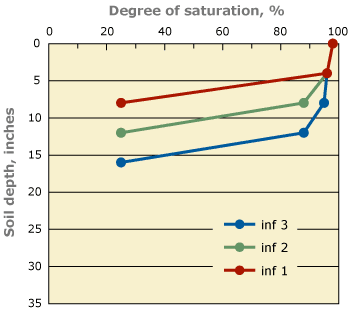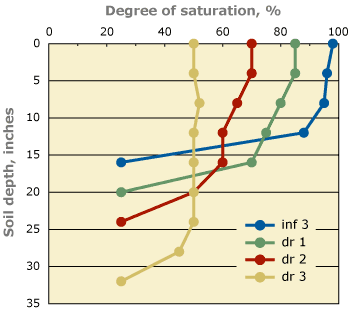- Home
- Learn about salinity
- Get to know your site
- Design a landscape
- Solve a problem
- Other information
Salinity Management Guide
What factors determine the degree to which salt accumulates in irrigated soil?
Movement of water through soil
Soil supports the establishment of plants — for example, the sprouting of seeds and the growth of seedlings — and provides necessary water and nutrients. Soil is able to do this because it is a porous material: water and air can enter and exit, relatively freely. When a permeable soil is irrigated, the applied water (or rainfall) readily infiltrates the soil, wetting the root zone. During this infiltration process the pore spaces in the wetted soil are nearly filled with water, a condition known as saturation.

Figure 1. Infiltration of water into a dry soil profile: three curves, corresponding to three successive points in time
Figure 1 shows infiltration curves (water entry curves) for three successive time points for soil that is initially dry. As infiltration proceeds, a wetted zone forms. After a while, the wetted zone progresses downward, as suggested by the curves.
Wetted soil is subject to drainage vertically, in response to gravitational forces. The draining of a saturated or nearly saturated permeable soil typically continues until about two to three days have passed. About one-half of the water present at saturation is drained out, resulting in a soil moisture condition known as field capacity (FC). At field capacity, the remaining water is held by negative pressure (suction) as a thin film lining the pore spaces, and the movement of water through the soil essentially ceases.

Figure 2. Drainage curves for three successive points in time after infiltration has ceased
Figure 2 shows a family of three soil drainage curves, plus curve inf3 from Figure 1. Each of the drainage curves corresponds to a particular time point after water has ceased infiltrating into the soil. Curve inf3 represents the moisture profile immediately after infiltration has ceased. Curves dr2 and dr3 represent the later stages of the draining process. After the last (latest) of these time points, drainage has wetted the deeper portions of the profile and the soil is approaching field capacity — as can be seen by the relatively constant 50% degree of saturation for all depths above about 25 inches.
| « Previous page | Next page » |